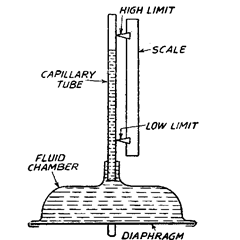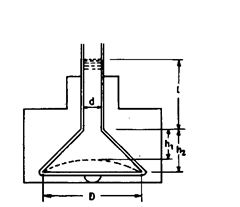5.9.
This type of comparator has limited applications due to some of the disadvantages
associated with it. But it is discussed here for the sake of the new and altogether different
method of magnification. In this comparator, a fine bore capillary tube is arranged so that its
lower end is placed in a chamber of relatively large cross-sectional area and containing a fluid
of low viscosity. At the bottom of the chamber, a diaphragm is fitted, which gets deflected by
pressure transmitted to it by the measuring plunger. Due to deflection of diaphragm, a small
quantity of liquid rises up in the capillary tube. A scale is arranged at the side of tube and limit
pointers are set relative to this to indicate the high and low limits of the dimension being
measured. These limits are obtained by master setting.
![]()
Fig. 5.54 shows the working of prestwich fluid gauge based on fluid displacement
comparator principle. Instrument body comprises of a cone shape with a thin base containing
a small button centrally. Any movement of the base causes a displacement of liquid up the
tube to indicate actual dimension. The change in volume of liquid in conical portion due to
![]()
The magnification of this type of comparator is usually of the order of 1500.
Various disadvantages of the instrument are :
(1) It is too much dependent upon the temperature as the fluid changes its volume with
change in temperature.
(2) The deflection of the diaphragm per unit measuring force is not constant.
(3) There is certain passivity in the instrument due to the characteristics of diaphragm
and the viscosity of the fluid.

Fig. 5.53. Fluid displacement comparator.

Fig. 5.54. Prestwitch fluid gauge.
Fluid Displacement Comparators [Fig. 5.53] (Metrology)
Next post: Optical Projectors (Metrology)
Previous post: Pneumatic Comparators (Metrology)
